香港会计准则17-固定资产
香港固定资产会计政策
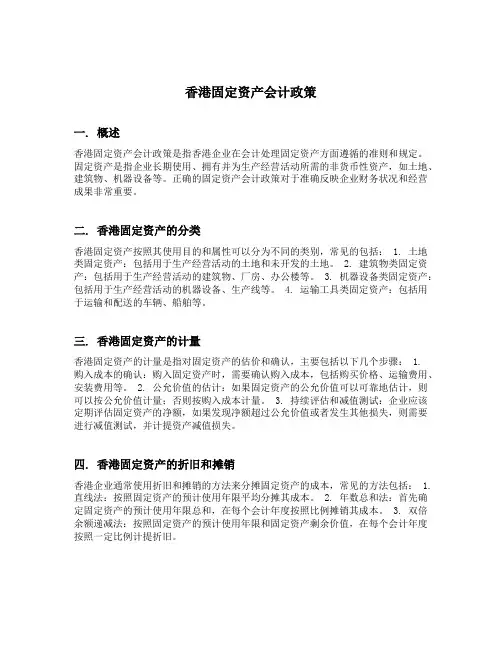
香港固定资产会计政策一. 概述香港固定资产会计政策是指香港企业在会计处理固定资产方面遵循的准则和规定。
固定资产是指企业长期使用、拥有并为生产经营活动所需的非货币性资产,如土地、建筑物、机器设备等。
正确的固定资产会计政策对于准确反映企业财务状况和经营成果非常重要。
二. 香港固定资产的分类香港固定资产按照其使用目的和属性可以分为不同的类别,常见的包括: 1. 土地类固定资产:包括用于生产经营活动的土地和未开发的土地。
2. 建筑物类固定资产:包括用于生产经营活动的建筑物、厂房、办公楼等。
3. 机器设备类固定资产:包括用于生产经营活动的机器设备、生产线等。
4. 运输工具类固定资产:包括用于运输和配送的车辆、船舶等。
三. 香港固定资产的计量香港固定资产的计量是指对固定资产的估价和确认,主要包括以下几个步骤: 1. 购入成本的确认:购入固定资产时,需要确认购入成本,包括购买价格、运输费用、安装费用等。
2. 公允价值的估计:如果固定资产的公允价值可以可靠地估计,则可以按公允价值计量;否则按购入成本计量。
3. 持续评估和减值测试:企业应该定期评估固定资产的净额,如果发现净额超过公允价值或者发生其他损失,则需要进行减值测试,并计提资产减值损失。
四. 香港固定资产的折旧和摊销香港企业通常使用折旧和摊销的方法来分摊固定资产的成本,常见的方法包括: 1. 直线法:按照固定资产的预计使用年限平均分摊其成本。
2. 年数总和法:首先确定固定资产的预计使用年限总和,在每个会计年度按照比例摊销其成本。
3. 双倍余额递减法:按照固定资产的预计使用年限和固定资产剩余价值,在每个会计年度按照一定比例计提折旧。
五. 香港固定资产的处置固定资产的处置是指固定资产在使用完毕或者不再需要时的处理方式,通常有以下几种: 1. 出售:将固定资产以出售的方式处置,获取出售收入。
2. 报废:固定资产在使用完毕后无法继续使用,需要进行报废处理。
内地与香港会计准则的差异
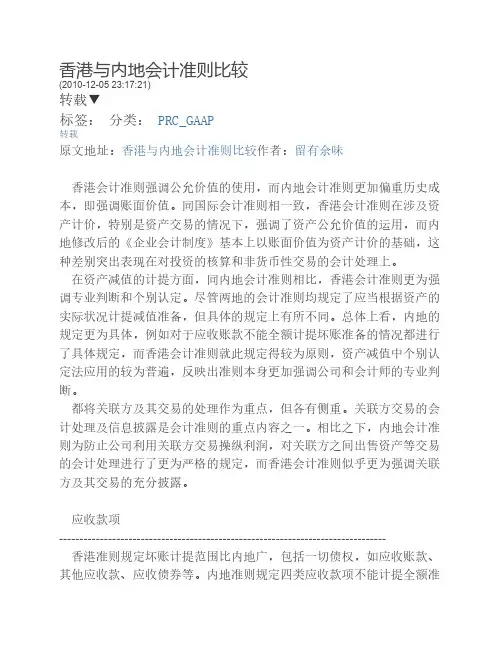
香港与内地会计准则比较(2010-12-05 23:17:21)转载▼标签:分类: PRC_GAAP转载原文地址:香港与内地会计准则比较作者:留有余味香港会计准则强调公允价值的使用,而内地会计准则更加偏重历史成本,即强调账面价值。
同国际会计准则相一致,香港会计准则在涉及资产计价,特别是资产交易的情况下,强调了资产公允价值的运用,而内地修改后的《企业会计制度》基本上以账面价值为资产计价的基础,这种差别突出表现在对投资的核算和非货币性交易的会计处理上。
在资产减值的计提方面,同内地会计准则相比,香港会计准则更为强调专业判断和个别认定。
尽管两地的会计准则均规定了应当根据资产的实际状况计提减值准备,但具体的规定上有所不同。
总体上看,内地的规定更为具体,例如对于应收账款不能全额计提坏账准备的情况都进行了具体规定,而香港会计准则就此规定得较为原则,资产减值中个别认定法应用的较为普遍,反映出准则本身更加强调公司和会计师的专业判断。
都将关联方及其交易的处理作为重点,但各有侧重。
关联方交易的会计处理及信息披露是会计准则的重点内容之一。
相比之下,内地会计准则为防止公司利用关联方交易操纵利润,对关联方之间出售资产等交易的会计处理进行了更为严格的规定,而香港会计准则似乎更为强调关联方及其交易的充分披露。
应收款项--------------------------------------------------------------------------------香港准则规定坏账计提范围比内地广,包括一切债权,如应收账款、其他应收款、应收债券等。
内地准则规定四类应收款项不能计提全额准备,而香港准则没有这方面的规定。
存货--------------------------------------------------------------------------------内地准则规定按先进先出、加权平均、移动平均、后进先出和分批实际法进行实际成本核算;而香港准则不接受后进先出和分批实际法,其余方法相同。
准则下固定资产及在建工程的减值准备【2017-2018最新会计实务】
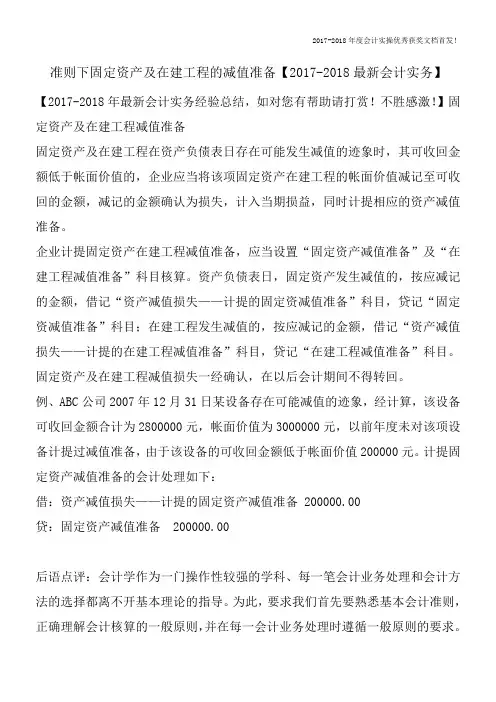
准则下固定资产及在建工程的减值准备【2017-2018最新会计实务】【2017-2018年最新会计实务经验总结,如对您有帮助请打赏!不胜感激!】固定资产及在建工程减值准备固定资产及在建工程在资产负债表日存在可能发生减值的迹象时,其可收回金额低于帐面价值的,企业应当将该项固定资产在建工程的帐面价值减记至可收回的金额,减记的金额确认为损失,计入当期损益,同时计提相应的资产减值准备。
企业计提固定资产在建工程减值准备,应当设置“固定资产减值准备”及“在建工程减值准备”科目核算。
资产负债表日,固定资产发生减值的,按应减记的金额,借记“资产减值损失——计提的固定资减值准备”科目,贷记“固定资减值准备”科目;在建工程发生减值的,按应减记的金额,借记“资产减值损失——计提的在建工程减值准备”科目,贷记“在建工程减值准备”科目。
固定资产及在建工程减值损失一经确认,在以后会计期间不得转回。
例、ABC公司2007年12月31日某设备存在可能减值的迹象,经计算,该设备可收回金额合计为2800000元,帐面价值为3000000元,以前年度未对该项设备计提过减值准备,由于该设备的可收回金额低于帐面价值200000元。
计提固定资产减值准备的会计处理如下:借:资产减值损失——计提的固定资产减值准备 200000.00贷:固定资产减值准备 200000.00后语点评:会计学作为一门操作性较强的学科、每一笔会计业务处理和会计方法的选择都离不开基本理论的指导。
为此,要求我们首先要熟悉基本会计准则,正确理解会计核算的一般原则,并在每一会计业务处理时遵循一般原则的要求。
会计学的学习,必须力求总结和应用相关技巧,使之更加便于理解和掌握。
学习时应充分利用知识的关联性,通过分析实质,找出核心要点。
要深入钻研,过细咀嚼,独立思考,切忌囫囵吞枣,人云亦云,随波逐流,粗枝大叶,浅尝辄止。
固定资产会计准则应用指南最新
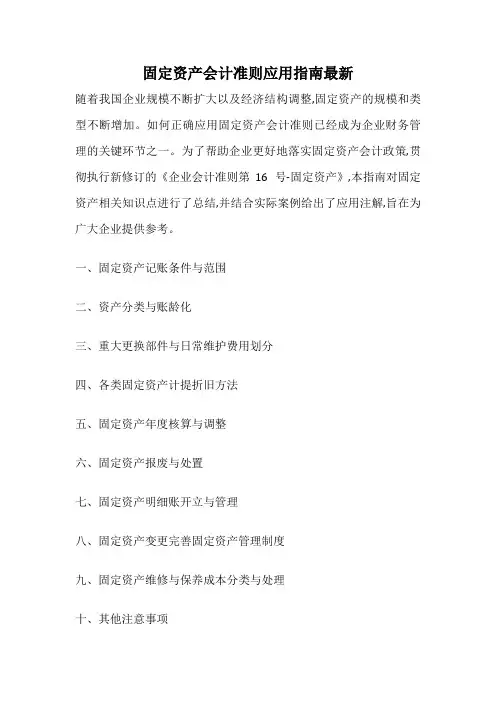
固定资产会计准则应用指南最新
随着我国企业规模不断扩大以及经济结构调整,固定资产的规模和类型不断增加。
如何正确应用固定资产会计准则已经成为企业财务管理的关键环节之一。
为了帮助企业更好地落实固定资产会计政策,贯彻执行新修订的《企业会计准则第16号-固定资产》,本指南对固定资产相关知识点进行了总结,并结合实际案例给出了应用注解,旨在为广大企业提供参考。
一、固定资产记账条件与范围
二、资产分类与账龄化
三、重大更换部件与日常维护费用划分
四、各类固定资产计提折旧方法
五、固定资产年度核算与调整
六、固定资产报废与处置
七、固定资产明细账开立与管理
八、固定资产变更完善固定资产管理制度
九、固定资产维修与保养成本分类与处理
十、其他注意事项
本指南归纳总结了固定资产核算与管理的重要环节,以便于企业财务人员正确执行固定资产政策,真实反映企业资产状况,为做好固定资产管理提供参考。
本指南将根据实际情况不断进行补充完善。
香港与内地会计准则比较
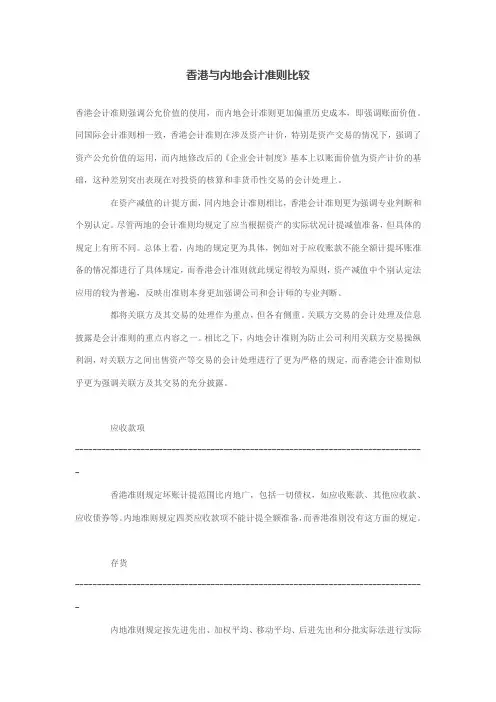
香港与内地会计准则比较香港会计准则强调公允价值的使用,而内地会计准则更加偏重历史成本,即强调账面价值。
同国际会计准则相一致,香港会计准则在涉及资产计价,特别是资产交易的情况下,强调了资产公允价值的运用,而内地修改后的《企业会计制度》基本上以账面价值为资产计价的基础,这种差别突出表现在对投资的核算和非货币性交易的会计处理上。
在资产减值的计提方面,同内地会计准则相比,香港会计准则更为强调专业判断和个别认定。
尽管两地的会计准则均规定了应当根据资产的实际状况计提减值准备,但具体的规定上有所不同。
总体上看,内地的规定更为具体,例如对于应收账款不能全额计提坏账准备的情况都进行了具体规定,而香港会计准则就此规定得较为原则,资产减值中个别认定法应用的较为普遍,反映出准则本身更加强调公司和会计师的专业判断。
都将关联方及其交易的处理作为重点,但各有侧重。
关联方交易的会计处理及信息披露是会计准则的重点内容之一。
相比之下,内地会计准则为防止公司利用关联方交易操纵利润,对关联方之间出售资产等交易的会计处理进行了更为严格的规定,而香港会计准则似乎更为强调关联方及其交易的充分披露。
应收款项--------------------------------------------------------------------------------香港准则规定坏账计提范围比内地广,包括一切债权,如应收账款、其他应收款、应收债券等。
内地准则规定四类应收款项不能计提全额准备,而香港准则没有这方面的规定。
存货--------------------------------------------------------------------------------内地准则规定按先进先出、加权平均、移动平均、后进先出和分批实际法进行实际成本核算;而香港准则不接受后进先出和分批实际法,其余方法相同。
固定资产--------------------------------------------------------------------------------(1)内地准则一般以资产的历史成本或净值计价,但香港准则容许资产重估并考虑折现的影响。
新企业会计准则资产负债表固定资产-概述说明以及解释
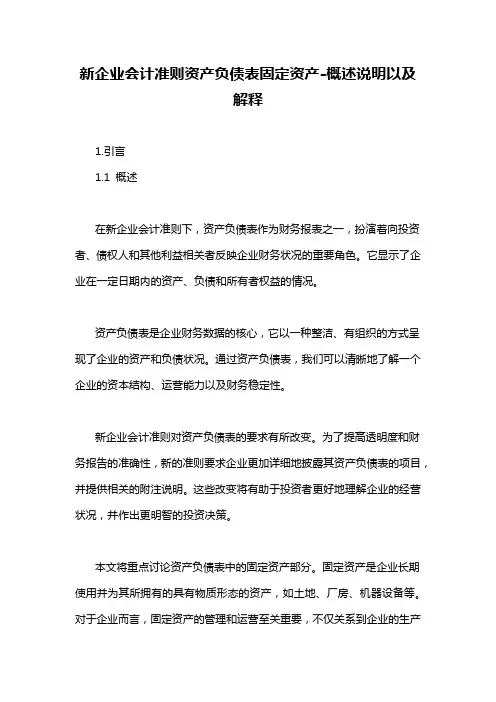
新企业会计准则资产负债表固定资产-概述说明以及解释1.引言1.1 概述在新企业会计准则下,资产负债表作为财务报表之一,扮演着向投资者、债权人和其他利益相关者反映企业财务状况的重要角色。
它显示了企业在一定日期内的资产、负债和所有者权益的情况。
资产负债表是企业财务数据的核心,它以一种整洁、有组织的方式呈现了企业的资产和负债状况。
通过资产负债表,我们可以清晰地了解一个企业的资本结构、运营能力以及财务稳定性。
新企业会计准则对资产负债表的要求有所改变。
为了提高透明度和财务报告的准确性,新的准则要求企业更加详细地披露其资产负债表的项目,并提供相关的附注说明。
这些改变将有助于投资者更好地理解企业的经营状况,并作出更明智的投资决策。
本文将重点讨论资产负债表中的固定资产部分。
固定资产是企业长期使用并为其所拥有的具有物质形态的资产,如土地、厂房、机器设备等。
对于企业而言,固定资产的管理和运营至关重要,不仅关系到企业的生产能力和效率,也对财务状况和业绩产生重要影响。
接下来的章节将进一步探讨新企业会计准则对资产负债表的影响,以及固定资产的定义、分类、重要性和管理。
通过对这些内容的深入了解,我们能够更好地理解新准则对企业资产负债表的要求,并为企业的固定资产管理提供指导和建议。
文章结构部分的内容可以包括以下几个方面:1.2 文章结构本文主要分为引言、正文和结论三部分。
1. 引言部分将对本文的主题进行概述,并介绍文章的结构和目的。
2. 正文部分将详细介绍新企业会计准则对资产负债表以及其中的固定资产的影响。
首先,将对新企业会计准则进行简介,包括其背景、目的和适用范围等内容。
然后,将对资产负债表进行概述,包括其基本构成和作用。
接着,将重点介绍固定资产的定义和分类,包括固定资产的特点、计量和披露要求等内容。
3. 结论部分将对新企业会计准则对资产负债表的影响以及固定资产的重要性和管理进行总结。
首先,将对新企业会计准则对资产负债表的影响进行归纳总结,包括对资产负债表报表格式、项目分类和披露要求等方面的影响。
中国会计规定与国际财务报告准则及香港财务报表准则的规定差异
中国会计规定与国际财务报告准则及香港财务报告准则的比较随着中国加入世界贸易组织﹐各界正积极就新机遇和挑战作出准备。
会计﹐有必要不断的更新以配合国内经济发展的步伐﹐但作为国际通用的商业语言﹐又不可与国际惯例有重大偏离。
为此﹐中华人民共和国财政部(以下简称“财政部”)不断就此方向作出努力﹐并取得了重大成果。
在1993年﹐财政部以世界银行的拨款﹐开始发展约30项适用于中国发展中社会主义市场经济的会计准则﹐旨在使中国的会计及财务编报实务能与国际接轨。
在1994年至1996年3年间﹐相关准则的征求意见稿已分批发出。
在2000年发展约17项会计准则﹐当中主要是国际会计准则委员会正在处理的项目及一些特殊行业的会计准则。
直至现时为止﹐共有16项《企业会计准则》(以下简称“具体准则”) 已经发出﹐而其它准则仍在制订中。
中国会计准则会计准则施行日期实施范围1.关联方关系及其交易的披露1997年1月1日上市公司2.现金流量表(2001年修订﹐只作出了有限度的修改) 2001年1月1日所有企业3.资产负债表日后事项(2003年修订) 2003年7月1日执行《企业会计制度》的企业4.债务重组(2001年修订﹐作出了重大修改) 2001年1月1日所有企业5.收入1999年1月1日上市公司6.投资(2001年修订﹐只作出了有限度的修改) 2001年1月1日股份有限公司(2001年1月1日前只实施在上市公司上)7.建造合同1999年1月1日上市公司8.会计政策、会计估计变更和会计差错更正2001年1月1日所有企业(2001年1月1日前只实施在上市公司上) (2001年修订﹐只作出了有限度的修改)9.非货币性交易(2001年修订﹐作出了重大修改) 2001年1月1日所有企业10.或有事项2000年7月1日所有企业11.无形资产2001年1月1日股份有限公司12.借款费用2001年1月1日所有企业13.租赁2001年1月1日所有企业14.中期财务报告2002年1月1日上市公司15.存货2002年1月1日执行《企业会计制度》的企业16.固定资产2002年1月1日执行《企业会计制度》的企业除了制定具体准则有长足进展外﹐在2000年底﹐财政部发布了新的《企业会计制度》(以下简称“新制度”)﹐并自2001年1月1日起应用在所有股份有限公司上。
新会计准则对固定资产的定义
新会计准则对固定资产的定义一、固定资产的概念固定资产是指企业长期使用、具有形体的、有形的、不易转换为现金的资产,用于生产经营活动的过程中。
根据新会计准则,固定资产包括以下几种类型: - 房屋及建筑物 - 机械设备 - 运输工具 - 电子设备 - 其他固定资产二、新会计准则对固定资产的定义新会计准则对固定资产的定义相对于旧会计准则有所变化。
根据新会计准则,固定资产的定义有以下要点:1. 可控性固定资产必须是企业可以控制并且为其所拥有的资产。
这意味着企业对该资产的使用权和收益权具有控制力。
此外,固定资产应该属于企业的所有权,即企业能够支配该资产并享受其中的经济利益。
2. 长期使用性固定资产是企业用于长期生产经营活动的资产,其使用期限通常超过一年。
企业在购买固定资产时,预期将其长期使用于生产经营活动中,并从中获得一定的收益。
3. 物质性固定资产是具有形体的有形资产,包括房屋、设备、车辆等。
与之相对应的,无形资产如专利权、商标权等则不属于固定资产的范畴。
4. 非易转换为现金固定资产通常不易转换为现金。
相对于流动资产,如现金、存货等,固定资产不能立即转换为现金,并且通常需要较长时间或以较高成本来变现。
5. 用于生产经营活动固定资产是为了进行生产经营活动而使用的资产,包括用于生产商品、提供服务或进行投资的各类资产。
这些资产在生产经营活动中起到重要的作用,并对企业的经营结果和财务状况产生影响。
三、新会计准则对固定资产的会计处理新会计准则对固定资产的会计处理也有一些变化。
以下是几个重要的会计处理原则:1. 初始计量固定资产的初始计量是指在资产购置时确定该资产的初始成本。
初始成本包括购买价款、相关税费以及将该资产投入使用时所需的直接费用。
新会计准则要求在初始计量时,将固定资产的成本分摊至预计使用寿命内。
2. 折旧计提固定资产通常会随着时间的推移而价值逐渐减少。
为反映固定资产的使用价值及衰减情况,企业需要计提折旧费用。
新会计准则讲解第4号──固定资产
企业会计准则──固定资产【字体:大中小】【打印】一、固定资产的确认1.固定资产是指同时具有下列特征的有形资产:(1)为生产商品、提供劳务、出租或经营管理而持有的;(2)使用寿命超过一个会计年度。
2.满足固定资产的确认条件(1)与该固定资产有关的经济利益很可能流入企业;(2)该固定资产的成本能够可靠地计量。
需要注意的两个问题:1)固定资产的不同组成部分固定资产的各组成部分具有不同使用寿命或者以不同方式为企业提供经济利益,适用不同折旧率或折旧方法的,应当分别将各组成部分确认为单项固定资产。
2)备品配件和维修设备备品配件和维修设备通常确认为存货,但符合固定资产定义和确认条件的,应当确认为固定资产。
如民用航空运输的高价周转件等。
二、固定资产的初始计量固定资产的初始计量,指确定固定资产的取得成本。
成本应包括企业为购建某项固定资产达到预定可使用状态前所发生的一切合理的、必要的支出。
固定资产的取得方式包括外购、自行建造、投资者投入、非货币性交易、债务重组等,取得方式不同,其成本的具体确定方法也不尽相同。
(一)外购固定资产的成本外购固定资产的成本,包括购买价款、使固定资产达到预定可使用状态前所发生的可归属于该项资产的运输费、装卸费、安装费和专业人员服务费等。
以一笔款项购入多项没有单独标价的固定资产,应当按照各项固定资产公允价值比例对总成本进行分配,分别确定各项固定资产的成本。
分录:不需安装:借:固定资产贷:银行存款应付票据长期应付款等需要安装:借:在建工程贷:银行存款原材料等安装完毕,交付使用:借:固定资产贷:在建工程例1:某企业购入一台不需要安装的设备,发票价格50 000元,增值税税额8 500元,发生的运费2 500元,款项全部付清。
借:固定资产61 000贷:银行存款61 000例2:某企业购入一台需要安装的设备,取得的增值税专用发票上注明的设备买价为50 000元,增值税额为8 500元,支付的运输费为1 000元,安装设备时,领用材料物资价值1 500元,购进该批材料时支付的增值税额为255元,支付工资2 500元。
香港会计准与内地会计准则比较
中国内地与香港会计实务核算比较[ 录入者:哈林| 时间:2005-12-27 20:54:38 | 作者:| 来源:][上一篇] [下一篇]外币核算香港关于外币核算处理的规定较为详细。
香港《会计实务准则》第11号规定:a.企业因外币交易而产生的每项资产、负债、收入、成本均按当日的市场汇率折算为编表货币单位,也可按实际的外币记账。
b.规定了外汇期货合同及外国子公司报表合并的外币处理方法。
中国内地在《企业财务通则》、《股份有限公司会计制度》、《外商投资企业会计制度》及行业会计制度中对外币业务核算作了较为详细的规定:a.企业发生外币业务时,按当时的国家外汇牌价作为记账汇率或按业务发生的当月月初的国家外汇牌价作为记账汇率进行折算。
b.企业各种外币项目(应指货币性项目)的期末余额,须按照期末国家外汇牌价折合成记账本位币金额,与账面记账本位币金额的差额作为财务费用――汇兑损益,计入当期损益。
c.企业发生的汇兑损益,在筹建期间发生的,计入开办费;生产经营期间发生的,计入财务费用;清算期间发生的,计入清算损益;与购建固定资产或无形资产有关的,在该资产完工入账前计入购建资产的价值。
d.以外币收支为主的企业,,可以某种外币为记账本位币,但编制报表时应折算为人民币反映。
中国内地还是外汇管制,外汇不能自由兑换,官方公布外汇牌价与市场真实汇率有一定的差价,不能真实反映外币业务情况。
目前仍没有规定外币期货合同和国外子公司报表折合成人民币的处理方法,而只作理论探讨。
存货核算1、存货在中国内地的分类有商品、产成品、半成品、在产品、材料、包装物、低值易耗品、周转材料归类为固定资产外,其余均为库存,但归类为产成品、在产品和原材料。
2、在中国内地,存货按先进先出、加权平均、移动平均、后进先出和分批实际法进行实际成本核算;香港则不接受后进先出和分批实际法,其余方法相同。
3、中国内地,存货按实际成本入账;香港则按成本与可变现净值孰低法。
- 1、下载文档前请自行甄别文档内容的完整性,平台不提供额外的编辑、内容补充、找答案等附加服务。
- 2、"仅部分预览"的文档,不可在线预览部分如存在完整性等问题,可反馈申请退款(可完整预览的文档不适用该条件!)。
- 3、如文档侵犯您的权益,请联系客服反馈,我们会尽快为您处理(人工客服工作时间:9:00-18:30)。
SSAP 17STATEMENT OF STANDARD ACCOUNTING PRACTICE 17PROPERTY, PLANT AND EQUIPMENT(Issued July 1995; revised April 2001 in bold type)The standards, which have been set in bold italic type, should be read in the context of the background material and implementation guidance and in the context of the Foreword to Statements of Standard Accounting Practice ,Interpretationsand Accounting Guidelines. Accounting standardsStatements of Standard Accounting Practiceare not intended to apply to immaterial items (see paragraph 8 of the Foreword).IntroductionThe objective of this Statement is to prescribe the accounting treatment for property, plant and equipment. The principal issues in accounting for property, plant and equipment are the timing of recognition of the assets, the determination of their carrying amounts and the depreciation charges to be recognised in relation to them , and the determination and accounting treatment of other impairments to the carrying amounts .Scope1.This Statement should be applied in accounting for property, plant and equipment exceptwhen another Statement of Standard Accounting Practice requires or permits a differentaccounting treatment.2.Charitable, government subvented and not-for-profit organisations whose long-termfinancial objective is other than to achieve operating profits (eg. trade associations, clubsand retirement schemes) are exempted from compliance with this Statement provided thatfull disclosure of their accounting policies is made. Nonetheless, these enterprises areencouraged to follow the accounting practices set out in this Statement.3. This Statement supersedes SSAP 6 "Depreciation accounting". While this Statement is notprimarily intended to apply to assets other than property, plant and equipment, many of theprinciples contained in this Statement may also be appropriate for other depreciable assets.does not apply to:Statement4. Thisa. forests and similar regenerative natural resources; andb. mineral rights, the exploration for and extraction of minerals, oil, natural gas and similarnon-regenerative resources.However, this Statement does apply to property, plant and equipment used to develop ormaintain the activities or assets covered in a. or b. but separable from those activities or assets.5. In some circumstances other Statements of Standard Accounting Practice permit the initialrecognition of the carrying amount of property, plant and equipment to be determined using an approach different from that prescribed in this Statement. For example, SSAP 7 "Groupaccounts" SSAP 30 "Business combinations" requires property, plant and equipment acquired in a business combination to be measured initially at fair value even when it exceeds cost.However in such cases all other aspects of the accounting treatment for these assets, including depreciation, are determined by the requirements of this Statement.Definitions6.The following terms are used in this Statement with the meanings specified:"Property, plant and equipment" are tangible assets that:a.are held by an enterprise for use in the production or supply of goods or services, forrental to others, or for administrative purposes; andb.are expected to be used during more than one period."Depreciation" is the systematic allocation of the depreciable amount of an asset over itsestimated useful life."Depreciable amount" is the cost of an asset, or other amount substituted for cost in thefinancial statements, less its estimated residual value."Useful life" is either:a.the period of time over which an asset is expected to be used by the enterprise; orb.the number of production or similar units expected to be obtained from the assets bythe enterprise."Cost" is the amount of cash or cash equivalents paid or the fair value of the otherconsideration given to acquire an asset at the time of its acquisition or construction."Residual value" is the net amount which the enterprise expects to obtain for an asset at the end of its useful life after deducting the expected costs of disposal."Fair value" is the amount for which an asset could be exchanged between knowledgable, willing parties in an arm's length transaction.An "impairment loss" is the amount by which the carrying amount of an asset exceeds itsrecoverable amount."Carrying amount" is the amount at which an asset is included recognised in the balancesheet after deducting any accumulated depreciation and accumulated impairment lossesthereon."Recoverable amount" is the amount which the enterprise expects to recover from thefuture use of an asset, including its residual value on disposal. "Recoverable amount" is the higher of an asset's net selling price and value in use.Recognition of property, plant and equipment7.An item of property, plant and equipment should be recognised as an asset when:a.it is probable that future economic benefits associated with the asset will flow to theenterprise; andb.the cost of the asset to the enterprise can be measured reliably.8. Property, plant and equipment is often a major portion of the total assets of an enterprise, andtherefore is significant in the presentation of its financial position. Furthermore, thedetermination of whether an expenditure represents an asset or an expense can have asignificant effect on an enterprise's reported results of operations.9. In determining whether an item satisfies the first criterion for recognition, an enterprise needsto assess the degree of certainty attaching to the flow of future economic benefits on the basis of the available evidence at the time of initial recognition. Existence of sufficient certainty that the future economic benefits will flow to the enterprise necessitates an assurance that theenterprise will receive the rewards attaching to the asset and will undertake the associatedrisks. This assurance is usually only available when the risks and rewards have passed to theenterprise.10. The second criterion for recognition is usually readily satisfied because the exchangetransaction evidencing the purchase of the asset identifies its cost. In the case of a self-constructed asset, a reliable measurement of the cost can be made from the transactions withparties external to the enterprise for the acquisition of the materials, labour and other inputsused during the construction process.11. Land and buildings in the course of development or redevelopment should be treated asfollows:a. Held for re-saleWhere land and buildings in the course of development or redevelopment are held for re-sale, they should be regarded as trading stocksinventories of an enterprise and as such,should be accounted for in accordance with SSAP 3 "Stocks and work inprogress".SSAP 22 "Inventories".b. Held for other purposesWhere land and buildings in the course of development or redevelopment are held forproduction, rental or administrative purposes or where no decision has yet been taken tore-sell the land and buildings, they should be included in the financial statements asproperty, provided that the recognition criteria in paragraph 7 are satisfied.12. In identifying what constitutes a separate item of property, plant and equipment, judgement isrequired in applying the criteria in the definition to specific circumstances or specific types of enterprises. It may be appropriate to aggregate individually insignificant items, such as moulds, tools and dies, and to apply the criteria to the aggregate value. Most spare parts and servicingequipment are usually carried as stocks inventory and recognised as an expense as consumed.However, major spare parts and stand-by equipment qualify as property, plant and equipment when the enterprise expects to use them during more than one period. Similarly, if the spareparts and servicing equipment can be used only in connection with an item of property, plantand equipment and their use is expected to be irregular, they are accounted for as property,plant and equipment and are depreciated over a time period not exceeding the useful life of the related asset.13. In certain circumstances, it is appropriate to allocate the total expenditure on an asset to itscomponent parts and account for each component separately. This is the case when thecomponent assets have different useful lives or provide benefits to the enterprise in a different pattern thus necessitating use of different depreciation rates and methods. For example,leasehold land and buildings acquired together need to be treated as separate depreciable assets if they have different useful lives.14. Property, plant and equipment may be acquired for safety or environmental reasons. Theacquisition of such property, plant and equipment, while not directly increasing the futureeconomic benefits of any particular existing item of property, plant and equipment may benecessary in order for the enterprise to obtain the future economic benefits from its otherassets. When this is the case, such acquisitions of property, plant and equipment qualify forrecognition as assets, in that they enable future economic benefits from related assets to bederived by the enterprise in excess of what it could derive if they had not been acquired.However, such assets are only recognised to the extent that the resulting carrying amount ofsuch an asset and related assets does not exceed the total recoverable amount of that asset and its related assets. For example, a chemical manufacturer may have to install certain newchemical handling processes in order to comply with environmental requirements on theproduction and storage of dangerous chemicals; related plant enhancements are recognised as an asset to the extent they are recoverable because, without them, the enterprise is unable tomanufacture and sell chemicals.Initial measurement of property, plant and equipment15.An item of property, plant and equipment which qualifies for recognition as an asset shouldinitially be measured at its cost.Components of cost16. The cost of an item of property, plant and equipment comprises its purchase price, includingimport duties and non-refundable purchase taxes, and any directly attributable costs of bringing the asset to working condition for its intended use; any trade discounts and rebates arededucted in arriving at the purchase price. Examples of directly attributable costs are:a. the cost of site preparation;b. initial delivery and handling costs;c. installation costs; andd. professional fees such as for lawyers, architects and engineers; ande. the estimated cost of dismantling and removing the asset and restoring the site, to theextent that it is recognised as a provision under SSAP 28 "Provisions, contingentliabilities and contingent assets".17. When payment for an item of property, plant and equipment is deferred beyond normal creditterms, its cost is the cash price equivalent; the difference between this amount and the totalpayments is recognised as interest expense over the period of credit unless it is capitalised inaccordance with guidance on borrowing costsSSAP 19 "Borrowing costs".18. Administration and other general overhead costs are not a component of the cost of property,plant and equipment unless they can be directly attributed to the acquisition of the asset orbringing the asset to its working condition. Similarly, start-up and similar pre-production costs do not form part of the cost of an asset unless they are necessary to bring the asset to itsworking condition.19. The cost of a self-constructed asset is determined using the same principles as for an acquiredasset. If an enterprise makes similar assets for sale in the normal course of business, the cost of the asset is usually the same as the cost of producing the assets for sale (see SSAP 22"Inventories") , and hence includes an appropriate proportion of production overheads.Therefore, any internal profits are eliminated in arriving at such costs. Similarly, the cost ofabnormal amounts of wasted material, labour, or other resources incurred in the production of a self-constructed asset is not included in the cost of the asset. SSAP 19 "Borrowing costs"establishes criteria which, when satisfied, will result in borrowing costs being capitalised as a component of property, plant and equipment. Guidance on determining whether or notborrowing costs might be included as a component of the cost of self- constructed assets can be found in Accounting Guideline 2.205 "Capitalisation of borrowing costs".20. The cost of an asset held by a lessee under a finance lease is determined using the principles setout in SSAP 14 "Accounting for leases and hire purchase contracts". SSAP 14 "Leases".Exchanges of assets21. An item of property, plant and equipment may be acquired in exchange or part exchange for adissimilar item of property, plant and equipment or other asset. The cost of such an item ismeasured at the fair value of the asset received, which is equivalent to the fair value of theasset given up adjusted by the amount of any cash or cash equivalents transferred. Such anexchange of assets is regarded as a transaction which generates gain or loss.22. An item of property, plant and equipment may be acquired in exchange for a similar asset thathas a similar use in the same line of business and which has a similar fair value. An item ofproperty, plant and equipment may also be sold in exchange for an equity interest in a similar asset. In both cases, since the earnings process is incomplete, no gain or loss is recognised onthe transaction. Instead, the cost of the new asset is the carrying amount of the asset given up.However, the fair value of the asset received may provide evidence of an impairment in theasset given up. Under these circumstances the asset given up is written down and this writtendown value assigned to the new asset. Examples of exchanges of similar assets include theexchange of aircraft, hotels, service stations and other real estate properties. If other assets such as cash are included as part of the exchange transaction this may indicate that the itemsexchanged do not have a similar value.Transfers between different types of assets23. An enterprise may, because of a change in use or intended use, transfer an asset betweenproperty, plant and equipment and other classes of assets, such as stocks or investmentproperties. The cost of such an asset on transfer is deemed to be the carrying amount of theasset as stated under its original classification. Any previous revaluation reserve on the assetshould be frozen upon the transfer until the retirement or disposal of the asset. On theretirement or disposal of the asset, the frozen revaluation reserve is transferred directly toretained earnings and not throught the profit and loss account.Subsequent expenditure2324.Subsequent expenditure relating to an item of property, plant and equipment that has already been recognised should be added to the carrying amount of the asset when it isprobable that future economic benefits, in excess of the originally assessed standard ofperformance of the existing asset, will flow to the enterprise. All other subsequentexpenditure should be recognised as an expense in the period in which it is incurred. 2425. Subsequent expenditure on property, plant and equipment is only recognised as an asset when the expenditure improves the condition of the asset beyond its originally assessed standard ofperformance. Examples of improvements which result in increased future economic benefitsinclude:a. modification of an item of plant to extend its useful life, including an increase in itscapacity;b. upgrading machine parts to achieve a substantial improvement in the quality of output;andc. adoption of new production processes enabling a substantial reduction in previouslyassessed operating costs.2526. Expenditure on repairs or maintenance of property, plant and equipment is made to restore or maintain the future economic benefits that an enterprise can expect from the originallyassessed standard of performance of the asset. As such, it is usually recognised as an expense when incurred. For example, the cost of servicing or overhauling plant and equipment isusually an expense since it restores, rather than increases, the originally assessed standard ofperformance.2627. The appropriate accounting treatment for expenditure incurred subsequent to the acquisition of an item of property, plant and equipment depends on the circumstances which were taken into account on the initial measurement and recognition of the related item of property, plant andequipment and whether the subsequent expenditure is recoverable. For instance, when thecarrying amount of the item of property, plant and equipment already takes into account a loss in economic benefits, the subsequent expenditure to restore the future economic benefitsexpected from the asset is capitalised provided that the carrying amount does not exceed therecoverable amount of the asset. This is also the case when the purchase price of an assetalready reflects the enterprise's obligation to incur expenditure in the future which is necessary to bring the asset to its working condition. An example of this might be the acquisition of abuilding requiring renovation. In such circumstances, the subsequent expenditure is added tothe carrying amount of the asset to the extent that it can be recovered from future use of theasset.2728. Major components of some items of property, plant and equipment may require replacement at regular intervals. For example, a furnace may require relining after a specified number of hours of usage or aircraft interiors such as seats and galleys may require replacement several timesduring the life of the airframe. The components are accounted for as separate assets becausethey have useful lives different from those of the items of property, plant and equipment towhich they relate. Therefore, provided the recognition criteria in paragraph 7 are satisfied, the expenditure incurred in replacing or renewing the component is accounted for as theacquisition of a separate asset and the replaced asset is written off.28. An enterprise that purchases an item of property, plant and equipment may need to performmajor inspections or overhauls of the asset at regular intervals over its useful life to allow thecontinued use of the asset by the enterprise. An example of this is the purchase of a vesselwhich requires an overhaul, say, once every five years.29. The cost of a major inspection or overhaul of an item of property, plant and equipmentoccurring at regular intervals over the useful life of an asset and made to allow the continueduse of the asset is recognised as an expense in the period in which it is incurred except when:a. consistent with paragraph 13, the enterprise has identified as a separate component of theasset an amount representing a major inspection or overhaul and has already depreciatedthat component to reflect the consumption of benefits which are replaced or restored bythe subsequent major inspection or overhaul (whether the asset is carried at historicalcost or revalued);b. it is probable that future economic benefits associated with the asset will flow to theenterprise; andc. the cost of the major inspection or overhaul to the enterprise can be measured reliably.If these criteria are met, the cost is capitalised and accounted for as a component of the asset(see Appendix).Measurement subsequent to initial recognition3029 . Subsequent to initial recognition as an asset, an item of property, plant and equipment should be carried at its cost less any accumulated depreciation , subject to the requirementin paragraph 55 to write an asset down to its recoverable amount and any accumulatedimpairment losses.3130. Alternatively, subsequent to initial recognition as an asset, an item of property, plant and equipment may be carried at a revalued amount, being its fair value at the date of therevaluation less any subsequent accumulated depreciation , and subsequent accumulatedimpairment losses.Subject to the transitional arrangements set out in paragraph 8072,revaluations should be made with sufficient regularity such that the carrying amount doesnot differ materially from that which would be determined using fair value at the balancesheet date.Revaluations3231. The fair value of land and buildings is usually its open market value. for existing use which presupposes continued use of the asset in the same or a similar business. This value isdetermined by appraisal normally undertaken by professionally qualified valuers.3332. The fair value of items of plant and equipment is usually their market value determined by appraisal. When there is no evidence of market value because of the specialised nature of theplant and equipment and because these items are rarely sold, except as part of a continuingbusiness, they are valued at their depreciated replacement cost.33. In determining fair value, an item of property, plant and equipment is valued on the basis of itsexisting use. However, an asset for which a change in use is probable is valued on the samebasis as other similar assets held for the same intended use. For example, it is inappropriate to value a factory and the equipment within it at their value in use, while valuing the factory site at the open market value of the land for redevelopment as a shopping centre.34. The frequency of revaluations depends upon the movements in the fair values of the items ofproperty, plant and equipment being revalued. When the fair value of a revalued asset differsmaterially from its carrying amount, a further revaluation is necessary. Some items of property, plant and equipment may experience significant and volatile movements in fair value thusnecessitating annual revaluation. Such frequent revaluations would be unnecessary for items of property, plant and equipment with only insignificant movements in fair value.35. When an item of property, plant and equipment is revalued, any accumulated depreciation atthe date of the revaluation is either:a. restated proportionately with the change in the gross carrying amount of the asset so thatthe carrying amount of the asset after revaluation equals its revalued amount. Thismethod is often used when an asset is revalued by means of an index to its depreciatedreplacement cost; orb. eliminated against the gross carrying amount of the asset and the resulting net amountrestated to the revalued amount of the asset. For example, this method is used forbuildings which are revalued to their open market value.The amount of the adjustment arising on the restatement or elimination of accumulateddepreciation forms part of the increase or decreasein carrying amount which is dealt with in accordance with paragraphs 39 and 40.36.When an item of property, plant and equipment is revalued, the entire class of property,plant and equipment to which that asset belongs should be revalued.37. A class of property, plant and equipment is a grouping of assets of a similar nature and use inan enterprise's operations. The following are examples of separate classes:a. land;b. land and buildings;c. construction in progress;d. machinery;e. ships;f. aircraft;g. motor vehicles;h. furniture and fixtures; andi. office equipment.38. The items within a class of property, plant and equipment are revalued simultaneously in orderto avoid selective revaluation of assets and the reporting of amounts in the financial statements which are a mixture of costs and values as at different dates. However, a class of assets may be revalued on a rolling basis provided revaluation of the class of assets is completed within ashort period of time and provided the revaluations are kept up to date.39.When an asset's carrying amount is increased as a result of a revaluation, the increaseshould be credited directly to equity under the heading of revaluation reserve. However, arevaluation increase should be recognised as income to the extent that it reverses arevaluation decrease of the same asset previously recognised as an expense.40.When an asset's carrying amount is decreased as a result of a revaluation, the decreaseshould be recognised as an expense. However, a revaluation decrease should be chargeddirectly against any related revaluation reserve to the extent that the decrease does notexceed the amount held in the revaluation reserve in respect of that same asset.41. The revaluation reserve included in equity may be transferred directly to retained earningswhen the reserve is realised. The reserve may be realised on the retirement or disposal of theasset. However, part of the reserve may be realised as the asset is used by the enterprise; insuch a case, the amount of the reserve realised is the difference between depreciation based on the revalued carrying amount of the asset and depreciation based on the asset's original cost.The transfer from revaluation reserve to retained earnings is not made through the profit andloss account income statement.42. For the purposes of paragraph 40, the term "that same asset" refers to an individual item ofproperty, plant and equipment. A portfolio approach to revaluations is therefore precluded.Where a revaluation decrease occurs, this is charged against the related revaluation reserveonly to the extent that the decrease does not exceed the amount held in the revaluation reserve in respect of "that same asset" Any excess is charged to profit or loss for the period. Depreciation4342. The depreciable amount of an item of property, plant and equipment should be allocated ona systematic basis over its estimated useful life. The depreciation method used should reflectthe pattern in which the asset's economic benefits are consumed by the enterprise. Thedepreciation charge for each period should be recognised as an expense unless it is included in the carrying amount of another asset.4443. As the economic benefits embodied in an asset are consumed by the enterprise, the carrying amount of the asset is reduced to reflect this consumption, normally by charging an expensefor depreciation. A revaluation of property, plant and equipment does not remove the need to charge depreciation. Furthermore, a depreciation charge is made even if the value of the asset exceeds its carrying amount.4544. The economic benefits embodied in an item of property, plant and equipment are consumed by the enterprise principally through the use of the asset. A depreciation charge would thereforebe provided from the date an asset can be put to effective use. However, other factors such astechnical obsolescence and wear and tear while an asset remains idle often result in thediminution of the economic benefits that might have been expected to be available from theasset. Consequently, all the following factors need to be considered in determining the usefullife of an asset:a. the expected usage of the asset by the enterprise. Usage is assessed by reference to theasset's expected capacity or physical output;b. the expected physical wear and tear, which depends on operational factors such as thenumber of shifts for which the asset is to be used and the repair and maintenanceprogramme of the enterprise, and the care and maintenance of the asset while idle;c. technical obsolescence arising from changes or improvements in production, or from achange in the market demand for the product or service output of the asset; andd. legal or similar limits on the use of the asset, such as the expiry dates of related leases. 4645. The useful life of an asset is defined in terms of the asset's expected utility to the enterprise.The asset management policy of an enterprise may involve the disposal of assets after aspecified time or after consumption of a certain proportion of the economic benefits embodied in the assets. Therefore, the useful life of an asset may be shorter than its economic life. Theestimation of the useful life of an item of property, plant and equipment is a matter ofjudgement based on the experience of the enterprise with similar assets.4746. Land and buildings are separable assets and are dealt with separately for accounting purposes, even when they are acquired together. Freehold land has an unlimited life and, therefore, is not depreciated. Leasehold land, however, is to be depreciated. Buildings have a limited life and,therefore, are depreciable assets. An increase in the value of the land on which a buildingstands does not affect the determination of the useful life of the building.4847. The depreciable amount of an asset is determined after deducting the estimated residual value of the asset. In practice, the residual value of an asset is often insignificant and therefore isimmaterial in the calculation of the depreciable amount. When an asset is carried at cost lessaccumulated depreciation and any accumulated impairment losses and the residual value islikely to be significant, the residual value is estimated at the date of acquisition and is notsubsequently increased for changes in prices. However, when an asset is carried at a revalued amount, a new estimate is made at the date of any subsequent revaluation of the asset. Theestimate is based on the residual value prevailing at the date of the estimate for similar assetswhich have reached the end of their useful lives and which have operated under conditionssimilar to those in which the asset will be used.48. When the purchase of an asset will involve the enterprise in significant dismantling, removal orrestoration costs, at the end of the asset's useful life, those costs are recognised as an expenseover the life of the asset either:a. by deducting the estimated costs in determining the residual value of the asset andthereby increasing the annual depreciation charge. Any resulting negative carryingamount is recognised as a liability; orb. when the estimated costs are not deducted in determining the residual value, byrecognising the costs as a separate expense over the life of the asset such that the liabilityfor these costs is fully provided for at the end of the asset's useful life.。
